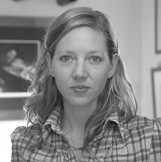2012 Contest: An Interview with Nonfiction Judge Maggie Nelson

Interview by BARRY GRASS
Black Warrior Review‘s annual nonfiction contest might not be very old, but it’s already established a tradition of being judged by the best names in literary nonfiction writing. Lia Purpura judged our inaugural nonfiction contest, and John D’Agata did the judging last year. 2012 is no exception, as none other than Maggie Nelson will judge!
Maggie Nelson is the author of four books of nonfiction: a critically acclaimed work of art and cultural criticism, The Art of Cruelty: A Reckoning (Norton, 2011); a meditation on the color blue, Bluets (Wave Books, 2009); a critical study of poetry and painting, Women, the New York School, and Other True Abstractions (University of Iowa Press, 2007; winner of the Susanne M. Glasscock Award for Interdisciplinary Scholarship, and a Creative Capital/Andy Warhol Foundation Arts Writers Grant); and an autobiographical book about sexual violence and media spectacle, The Red Parts: A Memoir (Free Press, 2007; named a Notable Book of the Year by the State of Michigan). Wouldn’t you like your nonfiction contest submission to be read by her? Of course you would!
In order to get to know Maggie a little bit better, I asked her a few questions about writing, music, and (as always, with me) food:
Black Warrior Review: The biggest issue in nonfiction writing this year has been the dustup over The Lifespan of a Fact. There were so many articles and debates and panels and brouhahas over that book, seemingly mostly from people who hadn’t read the book itself, just the early snippets that appeared in Harper’s. I don’t know how you feel about the whole thing (personally, I’m staunchly pro-D’Agata here), but I think you’ll agree with me when I say that there’s something stifling about the limited way in which we talk about nonfiction writing in this country. What do you think it is going to take – from readers, writers, journalists, etc. – for the discussion about nonfiction writing to move past debates over veracity and into debates about artistic merit, or anything else?
Maggie Nelson: Well, at the risk of sounding tautological, it’s going to take people focusing on issues beyond and besides veracity, as that debate kind of misses all the action. (Which is maybe fine – let the action be elsewhere, untouched & spreading.) I want to write about books like Dodie Bellamy’s The Buddhist, for example, which mixes together all kinds of important issues about contemporary nonfiction in one work (i.e. the gendered nature of the debates, the differences—or lack thereof—between experimental and more mainstream types of writing, the differences between blog writing and book writing, digital and print media/head space, and so on). You could say publications like the NYTBR need to get their heads out of their asses and review more literary nonfiction rather than uninventive memoirs, presidential biographies, and gimmicky, “Blink” style nonfiction books, but why wait for them to do so? There’s no shortage of good literary nonfiction out there, and its fans know it. It’s exploding.
BWR: What’s the best thing you’ve eaten this year?
MN: A strawberry popsicle after about 30 hours of labor. I threw it up soon after, but it was amazing going down.
BWR: When you open up a literary journal, what are you looking for out of its nonfiction section? Which is to say, what do you value, as a reader, in a magazine?
MN: Good sentences. An editorial impatience with uninteresting ones.
BWR: You are a writer that is often associated with the Lyric Essay. I find that term to be quite useful, but I’ve come to realize that many people use that term to mean wildly different things. Do you use Lyric Essay to describe your, or other’s, writing? If so, how do you characterize it?
MN: I don’t use it to describe my work, because I’ve never written anything that I thought of explicitly as an essay. (I’m trying to write more essay-like things now – it’s very different, and I don’t really have a clue how to do it.) On the other hand, I conceived of both my books The Red Parts and Bluets as continuous flows, albeit jagged up into titled or numbered pieces, and so treating them each as one long essay also seems kind of right. I don’t mind if anyone calls my work “lyric essay”; I don’t care much about classification, as it comes after the fact of the writing. “Lyric essay” likely covers a lot of writing that I like, but honestly, and I’m just speaking personally here, the words themselves kind of bug me. They make it sound like the pieces have to be self-contained and pretty, song-like. Whereas some of the work I like the most is more chafing, awkward—ugly, even. And sometimes sprawling—think of Wayne Koestenbaum’s recent Anatomy of Harpo, for example. That’s why I usually stick with the broader, albeit pretty boring, moniker, “creative nonfiction.”
BWR: What are your top 5 favorite albums?
MN: I can’t answer for all time, but I’ll tell you the records I’ve been listening to most often, most recently: Gillian Welch’s The Harrow and the Harvest, Murder City Devils (self-titled), Azealia Bank’s 1991, sitar by Subruto Roy Chowdhury, Woody Guthrie’s Nursery Days, and two amazing records by good friends, Tara Jane O’Neil’s A Ways Away and Lhasa Sela’s last record before her totally unfair & untimely death (self-titled, Lhasa).